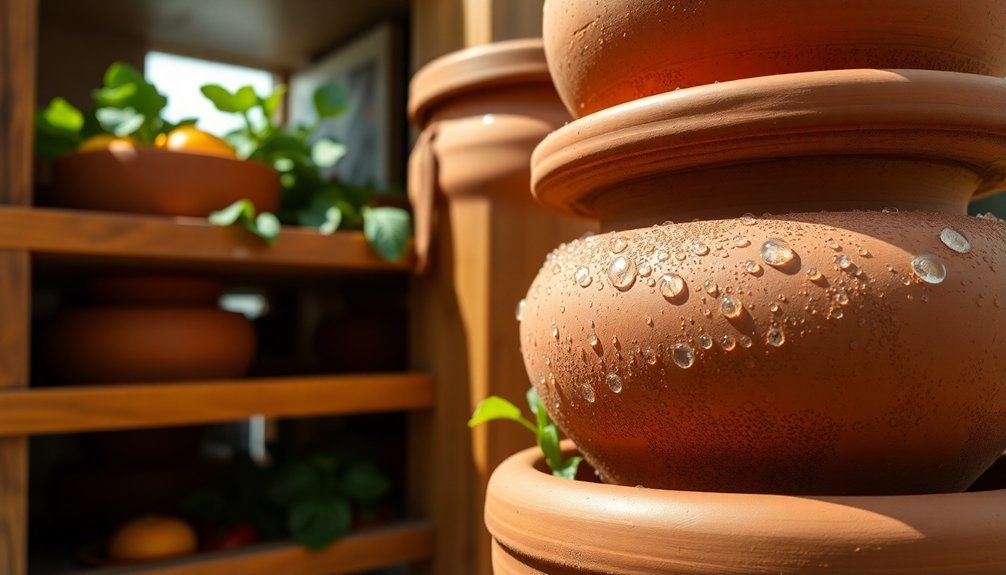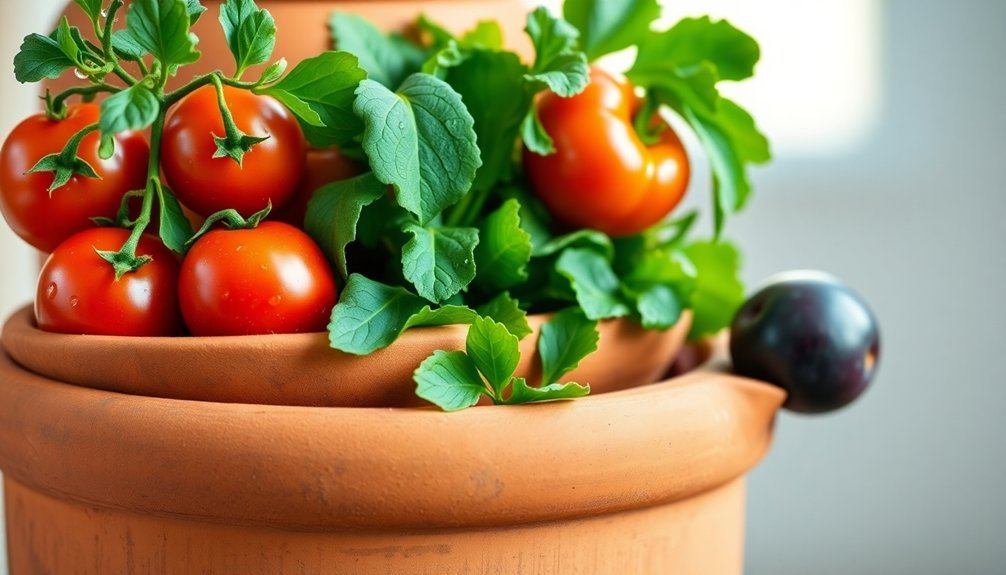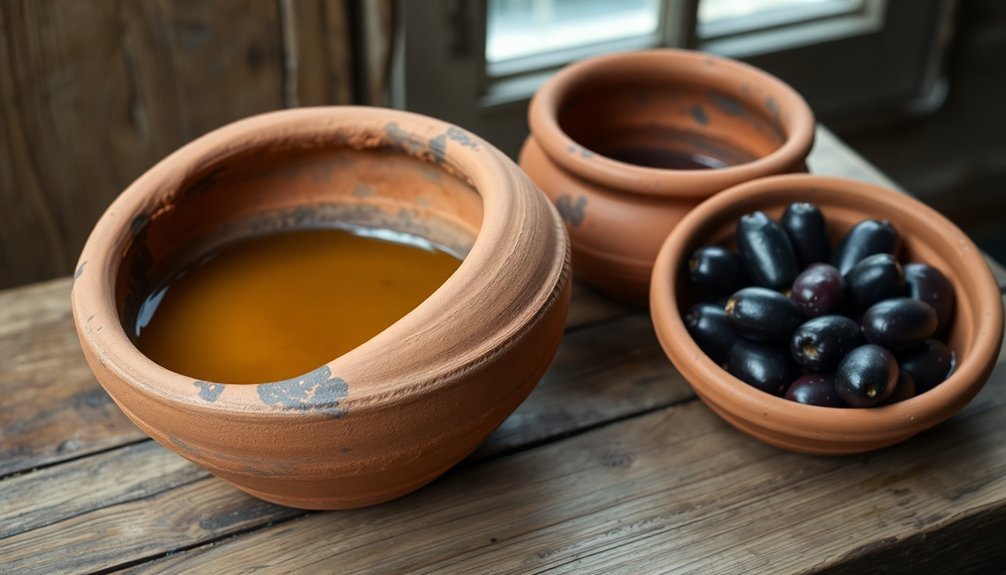Clay pot cooling systems can extend your food's shelf life up to four times longer than room temperature storage. You'll find that leafy greens stay fresh for over 4 days instead of just one, while vegetables like tomatoes, eggplant, and okra gain several extra days of freshness. The pots work through natural evaporative cooling, lowering internal temperatures by up to 10°C below the surrounding air. To get these results, you'll need to maintain proper water levels and place your clay pot cooler in a shaded, well-ventilated area. The secret to maximizing your food preservation lies in the details of setup and maintenance.
Cooling Science Behind Clay Storage

The science of evaporative cooling makes clay pot storage a remarkably effective method for preserving fresh produce. When water evaporates from the outer surface of the clay pot and the wet sand between the containers, it pulls heat away from the interior, creating a natural cooling effect. This process works much like your body's cooling mechanism through perspiration, lowering the internal temperature by up to 10°C below the surrounding air temperature.
You'll find that this cooling system depends heavily on proper environmental conditions to work effectively. The pots need to be placed in a shaded, well-ventilated area where air can freely circulate around them. This simple technology has proven particularly valuable in high-temperature regions where access to electricity is limited.
You must keep the sand between the pots and the covering cloth consistently damp to maintain the cooling effect. If either dries out, the evaporative process stops, and the cooling effect diminishes.
The increased humidity inside the clay pot system helps preserve your produce by preventing excessive moisture loss. However, this means you'll need to be selective about what you store, as some items like garlic and potatoes don't fare well in humid conditions.
Food Shelf Life Duration
Building on the cooling principles of clay pot storage, you'll notice remarkable differences in how long your produce stays fresh. Your leafy greens, which typically last only a day at room temperature, will remain fresh for over four days in a clay pot cooler.
You'll find that tomatoes gain several extra days of freshness, while vegetables like eggplant and okra show significant shelf life improvements. Proper temperature monitoring is crucial for food safety and quality control.
The extended storage time means you won't need to make daily trips to the market anymore. Instead, you can reduce your shopping frequency to twice a week, saving both time and money.
The cooler's ability to maintain temperatures up to 10°C below the surrounding environment helps prevent rapid spoilage that's common in standard room temperature storage.
To achieve these preservation times, you'll need to place your clay pot cooler in a shady, well-ventilated area. Keep the sand wet and the cloth damp to maintain the cooling effect.
Regular cleaning is essential for peak performance. While traditional room temperature storage can lead to food losses of up to 50% in hot climates, your clay pot cooler provides an affordable solution, costing between $5 and $40.
Building Your Clay Pot Cooler

Before assembling your clay pot cooler, you'll need to gather the essential components: two unglazed clay pots of different sizes, clean sand, silicone sealant, and basic hardware like washers, bolts, and nuts.
These natural coolers can help preserve vegetables for up to several weeks in optimal conditions.
Start by preparing the central bolt assembly, adding broad washers and applying silicone sealant before securing it with a nut.
You'll need to seal the drainage hole in the outer pot using silicone sealant – this step might require an extra pair of hands.
Next, position your pot feet or spacers inside the larger pot to create a stable base for the inner container.
Place the smaller pot carefully onto the washer, ensuring it's properly sealed and centered.
Once you've confirmed the positioning, pour sand into the gap between the two pots, being careful to avoid covering the washer and pot feet.
For enhanced cooling performance, you can add decorative rocks around the top to increase the evaporative surface area.
Consider mounting a thermometer to monitor internal temperatures.
You'll find various design options available, from the traditional nested pot arrangement to alternatives using plastic basins, but the basic assembly principles remain the same.
Daily Maintenance Requirements
Successfully maintaining your clay pot cooler requires consistent daily attention to keep it working effectively. You'll need to focus on keeping the sand between the pots wet and guaranteeing proper humidity levels by covering the cooler with a damp cloth.
| Task | Frequency |
|---|---|
| Check water levels | 2-3 times daily |
| Clean inner pot | Weekly |
| Monitor temperature | Daily |
| Inspect for damage | Weekly |
| Change sand water | Every 1-2 days |
Don't use soap or detergents when cleaning your cooler, as clay absorbs these substances. Instead, use natural cleaners like rice flour or besan flour with a coconut scrubber. You'll want to dry the pot thoroughly after cleaning to prevent mold growth.
Keep your cooler in a shady, well-ventilated area away from direct sunlight. You'll need to regularly check the temperature inside to guarantee it's maintaining proper cooling conditions. If you notice any performance issues, adjust the water levels and cloth coverage accordingly. Watch for signs of leakage or damage, and address these problems immediately to maintain your cooler's effectiveness.
Storage Location and Environment

The ideal spot for your clay pot cooler can make or break its effectiveness. You'll want to place it in a shady area with good ventilation, away from direct sunlight and heat sources. The location should allow natural breezes to circulate around the cooler while protecting it from extreme weather conditions.
Your storage environment plays an essential role in the cooler's performance. The area shouldn't be too humid or too dry, as this affects the evaporative cooling process. When properly placed, the inside of your pots can maintain temperatures up to 10°C below the surrounding air, creating favorable conditions for food preservation.
Keep your cooler away from areas with strong odors, dust, or dirt that could contaminate your produce. You'll also want to avoid spaces prone to flooding or excessive moisture.
The right environment will help you store fruits and vegetables for more than four days, compared to just one day in ambient conditions. This extended shelf life applies to various produce, including tomatoes, leafy greens, eggplant, and okra. A well-placed cooler reduces spoilage and means fewer trips to the market, saving you time and resources.
Frequently Asked Questions
Can Clay Pot Coolers Be Used in Tropical, Humid Climates Effectively?
Yes, you'll find clay pot coolers effective in tropical, humid climates. While humidity reduces their cooling efficiency, they'll still lower temperatures by 5-10°C and maintain high interior humidity, helping preserve your produce.
How Long Does a Clay Pot Cooler Typically Last Before Needing Replacement?
With proper maintenance, your clay pot cooler can last several years, but there's no definitive lifespan data. You'll need to monitor for cracks, damage, or reduced cooling efficiency to determine when replacement's necessary.
Is It Safe to Store Different Types of Foods Together?
You'll need to separate raw and cooked foods to prevent cross-contamination. While you can store compatible produce together, keep meats and dairy separate. Always use sealed containers and follow proper storage guidelines.
What Signs Indicate That a Clay Pot Cooler Needs Repairs?
You'll need repairs if you notice cracks, leaks, broken pieces, or inconsistent cooling. Watch for mold growth, white residue buildup, and constantly dry sand between pots. Check regularly for these warning signs.
Can Clay Pot Coolers Be Used During Winter Months?
You can use clay pot coolers during winter, but they won't be as effective since cold temperatures reduce evaporation. In humid winter conditions, you'll get less cooling benefit and shorter food preservation times.
In Summary
You'll find clay pot storage both sustainable and effective for extending your food's shelf life. When you maintain proper water levels and place your pots in a well-ventilated area, they'll keep fruits and vegetables fresh for 10-14 days longer than room temperature storage. Remember to clean your pots regularly and monitor humidity levels for peak performance. It's an ancient method that's still relevant for modern food preservation.





Leave a Reply